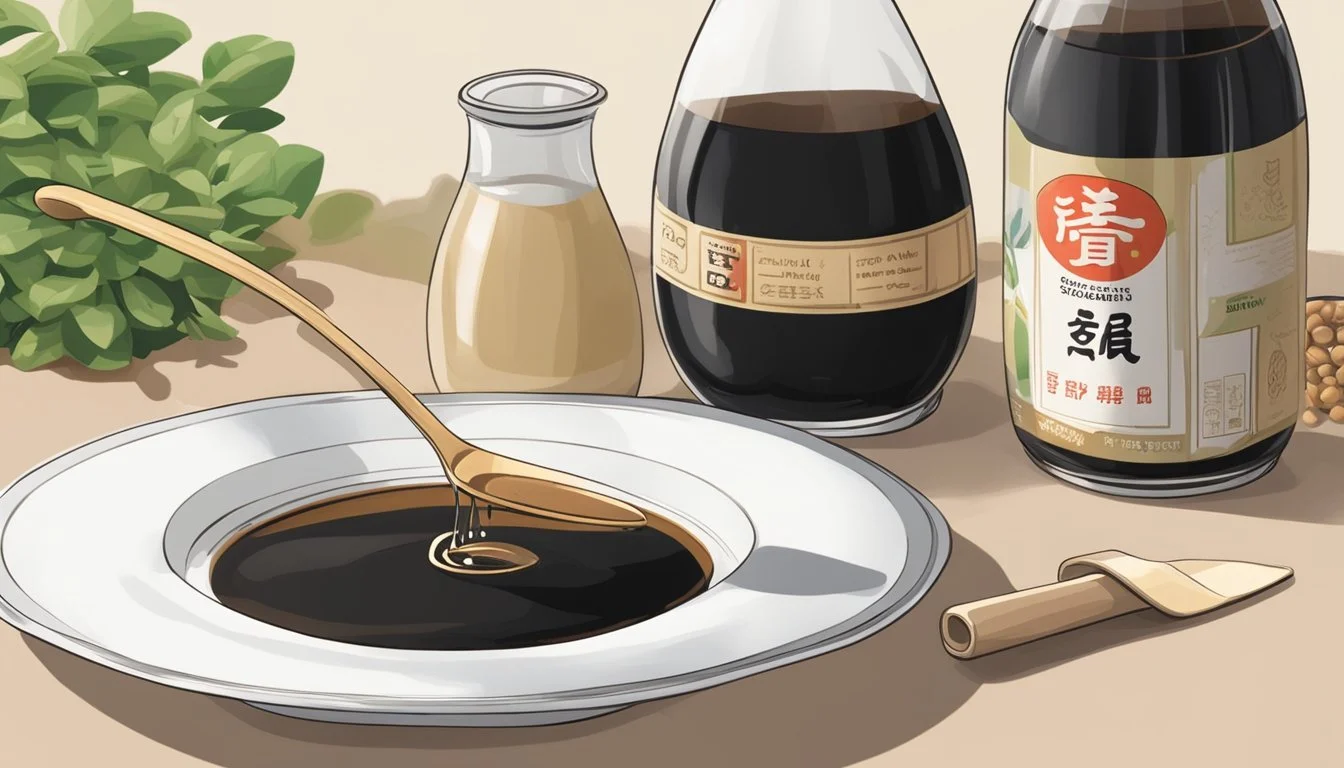How to Substitute Soy Sauce for Tamari
A Simple Guide for Your Recipes
Tamari and soy sauce are both products of fermented soybeans, commonly used in Asian cuisine to add a savory, umami quality to dishes. Tamari is traditionally tied to the Japanese kitchen, often favored for its richer and slightly milder taste when compared to its Chinese cousin, soy sauce. While tamari is a specific type of soy sauce, it is typically made without wheat, making it a gluten-free option, which soy sauce usually is not. This difference is important for those with gluten sensitivities or celiac disease, as it dictates whether they can enjoy a particular product as part of their diet.
When a recipe calls for tamari and it is not available, soy sauce steps up as the closest substitute. Soy sauce can be directly swapped for tamari in equal parts, lending a very similar flavor profile to that of tamari. The distinction in the taste between the two condiments arises mainly from the presence of wheat in soy sauce, which imparts a sharper edge and a somewhat lighter color. Cooks should be aware of these subtle differences when using soy sauce in place of tamari, considering any potential dietary restrictions and the desired outcome of their culinary creations.
Understanding Soy Sauce and Tamari
When exploring the culinary versatility of soy sauce and tamari, one must consider their distinct origins, flavor profiles, and nutritional values. Both are fundamental ingredients in Asian cuisine, offering that quintessential umami taste.
Origins and Differences
Tamari is a type of Japanese soy sauce that traditionally contains little to no wheat, making it a gluten-free option. It is a byproduct of miso paste production and tends to have a richer flavor and thicker consistency than its counterparts.
Soy sauce, on the other hand, is made from a mixture of soybeans and wheat, which undergoes fermentation. The inclusion of wheat contributes to a slightly sweeter taste and a thinner consistency than tamari. There are various styles of soy sauce depending on the region, but all contain wheat to some extent, with the proportion affecting flavor and texture.
Nutritional Values
Analyzing the nutritional content of tamari and soy sauce reveals differences primarily in their gluten content and sodium levels. Consumers with celiac disease or gluten sensitivity should carefully read labels to ensure they choose a truly gluten-free tamari.
Nutrient Tamari (per tablespoon) Soy Sauce (per tablespoon) Sodium Approx 940mg Approx 1020mg Calories 20 10 Carbohydrates 3g 1g
While both condiments are high in sodium, tamari often offers a slightly lower sodium level than traditional soy sauce. However, one should still use these sauces in moderation to control sodium intake.
Assessing the Need for Substitution
When looking to replace tamari in a recipe, it's important to understand why substitution is necessary and what dietary restrictions must be considered. This ensures the chosen alternative complements the dish's flavor profile while adhering to health or dietary needs.
Reasons for Substituting Tamari
Tamari is a rich, less salty, gluten-free soy sauce variant that is favored for its pure soybean flavor, and substituting it may arise from several motives. Some individuals may find tamari is not readily available in their local stores, or it might be a matter of personal taste preference. Others might substitute tamari to access different flavor nuances that other sauces offer.
Considerations for Dietary Restrictions
Those with dietary restrictions are often most impacted when a tamari substitute is needed. Here, the substitution complexity deepens:
Gluten Allergy or Sensitivity: Though tamari is usually gluten-free, always double-check labels as some brands vary. It's essential to opt for a gluten-free substitute like liquid aminos or coconut aminos if gluten is a concern.
Soy Allergy: For individuals allergic to soy, a soy-free substitute like coconut aminos, which imparts a similar sweet and salty flavor profile, is necessary.
Sodium Intake: Soy sauces generally have a high sodium content. Selecting a substitute that is lower in salt may be beneficial for those watching their sodium intake. Adjustments may be needed to achieve the desired taste.
In these situations, label scrutiny is crucial, and one should be prepared to make additional seasoning adjustments to maintain the desired flavor balance in their dish.
Tamari Substitute Options
When seeking alternatives for tamari sauce, one must consider whether a gluten-free option is necessary and if the substitute should be soy-based. The chosen substitute can impact the salty and umami depth similar to that provided by tamari.
Gluten-Free Alternatives
For those avoiding gluten, coconut aminos offer a sweeter, less salty flavor and are an excellent gluten-free substitute barely impacting the recipe’s integrity. Another option is gluten-free soy sauce which closely mimics tamari's flavor without containing wheat. Liquid aminos, another gluten-free choice, may require additional flavor enhancers such as garlic or fish sauce to achieve tamari's depth.
Coconut aminos: Sweeter, less salty, ideal for those allergic to soy.
Gluten-Free Soy Sauce: Made without wheat, closely resembles tamari's taste.
Liquid aminos: May need extra flavoring elements for full umami experience.
Soy-Based Substitutes
Soy sauce is the most direct substitute for tamari; though it typically contains wheat, it shares a similar umami profile. One can directly swap soy sauce in equal measure. Miso paste diluted in water can also replicate tamari's savory qualities in soups and marinades.
Soy Sauce: Contains wheat, has a similar savory flavor, use in a 1:1 ratio.
Miso Paste: Combine with water for a substitute in soups and marinades.
Non-Soy Substitutes
Alternatives not derived from soy include fish sauce and oyster sauce, offering a robust umami flavor with a hint of seafood. Hoisin sauce provides a distinctly sweet and salty taste, suitable for glazes and dips. Worcestershire sauce, while tangy and complex, can imbue dishes with a similar depth when added judiciously. Umeboshi vinegar, made from pickled plums, introduces a fruity sourness along with umami.
Fish Sauce: Strong umami with seafood flavor, use sparingly.
Oyster Sauce: Thick, rich in umami; adjust quantity to taste.
Hoisin Sauce: Sweet and salty, works well for glazes and dipping sauces.
Worcestershire Sauce: Complex and tangy, used sparingly can add depth.
Umeboshi Vinegar: Sour and fruity with umami undertones.
Tips for Substituting in Recipes
When substituting soy sauce for tamari, one must consider the dish's overall flavor profile, as well as the need to balance saltiness and umami. It is essential to modify quantities and ratios to achieve a result that closely resembles the intended taste of using tamari.
Adjusting Saltiness and Umami
Tamari is known for its rich umami flavor and is less salty compared to traditional soy sauce. When using soy sauce as a substitute, it's important to adjust the salt content in the rest of the recipe to avoid an overly salty dish. A good rule of thumb is to start with a smaller quantity of soy sauce and taste as you go. To enhance the umami without adding more salt, consider incorporating ingredients that are rich in savory flavor, such as miso paste or anchovies. (What wine goes well with anchovies?) These can complement the soy sauce and create a depth of flavor similar to tamari.
One may also add a pinch of sugar to balance the increased saltiness and closely mimic tamari's subtle sweetness. Additionally, incorporating a small amount of vinegar can adjust the flavor subtly, offering a touch of tartness that works well in many dishes.
Modifying Quantities and Ratios
The substitution of soy sauce for tamari is generally a one-to-one ratio; however, consider the sodium content and the overall savory flavor when making the switch. The following table helps clarify how one might adjust the ratio of soy sauce depending on the accompanying ingredients:
Ingredient added Soy Sauce Salt reduction Sugar Vinegar Miso Paste 1 tbsp 1/4 tsp — — Anchovy 1 tbsp 1/4 tsp — 1/2 tsp
If the recipe requires a gluten-free option, one may need to seek out specific gluten-free soy sauce brands to maintain the dietary requirement met by traditional tamari. It is crucial to read labels for those with gluten sensitivities.
Integration into Different Cuisines
When substituting soy sauce for tamari, it's essential to consider the cuisine and specific dish, as the integration can vary in taste and consistency. The impact on the culinary outcome is particularly distinct between Japanese and Asian dishes as well as Western-influenced recipes.
Japanese and Asian Dishes
In Japanese and Asian cuisines, the subtleties of flavor are paramount. Soy sauce can be a suitable substitute for tamari in dishes such as sushi, where it can complement the taste without overpowering the delicate flavors of the fish. However, chefs should use it sparingly due to its slightly saltier profile.
Noodles: For noodle dishes, such as ramen or soba, soy sauce can be added directly into the broth or used as part of a seasoning sauce, lending its umami character to the dish.
Stir-fry: When stir-frying vegetables or proteins, the use of soy sauce can provide both the saltiness and the rich color associated with the dish.
Rice dishes: In rice dishes, such as fried rice, soy sauce is an integral component that adds both flavor and a signature caramelized color.
Dumplings: For dipping sauces accompanying dumplings, soy sauce can replace tamari, adjusting quantities to taste to prevent the sauce from becoming too salty.
Western-Influenced Recipes
Western cuisine has embraced soy sauce as an ingredient, often using it to bring the umami flavor to a range of recipes.
Roasted: In Western-style roasted recipes, soy sauce can serve as a marinade or glaze for meats like chicken or beef, providing a savory depth that parallels the effects of tamari.
Teriyaki: Though originally Japanese, teriyaki has been adopted into Western cooking. When making teriyaki sauce, soy sauce can stand in for tamari, balancing the sweetness of the sugar and mirin with its intrinsic savoriness.
Asian-inspired cooking: For dishes that are Asian-inspired but not traditionally Asian, such as Asian fusion salads or bowls, soy sauce is an adaptable ingredient that can achieve the desired umami without drastically altering the flavor profile established by tamari.
Creating Homemade Tamari Alternatives
When looking to replicate tamari's unique taste and characteristics at home, one can employ various fermenting methods and combine select flavoring ingredients. These alternatives aim to match tamari's rich umami profile and can be suitable for those with specific dietary requirements.
DIY Tamari Alternatives
Creating a tamari alternative involves combining ingredients that imbue the savory, umami quality characteristic of traditional tamari. One can start with a base of soy sauce and modify it to closely match tamari's flavor and texture. Here is a simplified version of ingredients that can be used:
Tamarind paste: Incorporate to mimic the tangy aspect of tamari.
Molasses: Add a teaspoon to lend the mixture a slight sweetness and the desired thickness.
Vinegar: A dash of rice or white vinegar balances the concoction with a hint of acidity.
Fish sauce: A small amount can enhance the umami depth, similar to tamari's.
Sugar: If additional sweetness is needed, consider a pinch of sugar.
Anchovies: Finely minced anchovies can be a secret ingredient to boost umami and saltiness.
Combine these ingredients in small increments until the desired flavor profile is achieved. Keep in mind that while this will not be an exact match, it can serve as a close facsimile in recipes.
Fermenting and Flavoring Techniques
To embark on the path of fermenting a homemade tamari alternative, it is crucial to understand the significance of probiotics and fermentation. Fermenting soybeans is the traditional method to derive the rich flavor of tamari. One can create a similar base by fermenting cooked soybeans with a probiotic culture and allowing the mixture to ferment for several days, or until the desired taste is achieved.
Additional flavoring can be achieved through:
Molasses: For added sweetness and dark color.
Vinegar: To introduce some acidity and brightness to the profile.
Anchovies: Offering proteins and a boost in umami and salty flavors.
During fermentation, it is also important to consider the levels of protein and fiber as they contribute to the overall texture and health benefits of the sauce. Finally, ensure the absence of preservatives to maintain the natural and healthful qualities of the tamari alternative.
Understanding Food Labels and Marketing
When substituting soy sauce for tamari, consumers should be mindful of food labels and marketing strategies to ensure they are selecting the appropriate product for their dietary needs.
Labeling Laws and Regulations
In the United States, food labeling laws, overseen by the Food and Drug Administration (FDA), mandate that certain information be disclosed on product packaging. For items like soy sauce and tamari, key information such as the presence of allergens—including gluten—must be clear. When looking for a gluten-free alternative, consumers must scrutinize labels for certification marks or allergen statements. For those requiring a gluten-free soy sauce, the label should explicitly state "gluten-free," as regular soy sauce often contains wheat.
Moreover, the term "tamari" may be used on labels to market soy sauce that's specifically a Japanese style, which is traditionally made with little to no wheat, making it potentially suitable for a gluten-free diet. However, consumers need to check labels carefully because some products marketed as tamari may still contain small amounts of wheat.
Identifying Authentic Products
Authenticity can be a significant concern, especially for those looking for traditional pantry staples. True tamari is a byproduct of miso paste and should contain only soybeans and, occasionally, a minimal amount of wheat. To identify an authentic product, consumers should look for key phrases such as "traditionally brewed" or "naturally fermented" on labels. These terms suggest that traditional methods were used, which typically yield a richer flavor profile and potentially a gluten-free product if made solely from soybeans.
For those adhering to a vegan diet, additional scrutiny of labels is necessary to confirm the absence of animal products. Although tamari and soy sauce are generally vegan, certifications such as "Certified Vegan" on labels can provide an extra layer of assurance.
To make wise purchasing decisions, shoppers must be knowledgeable about labeling regulations and utilize this information to find suitable products that adhere to their dietary restrictions and preferences.







